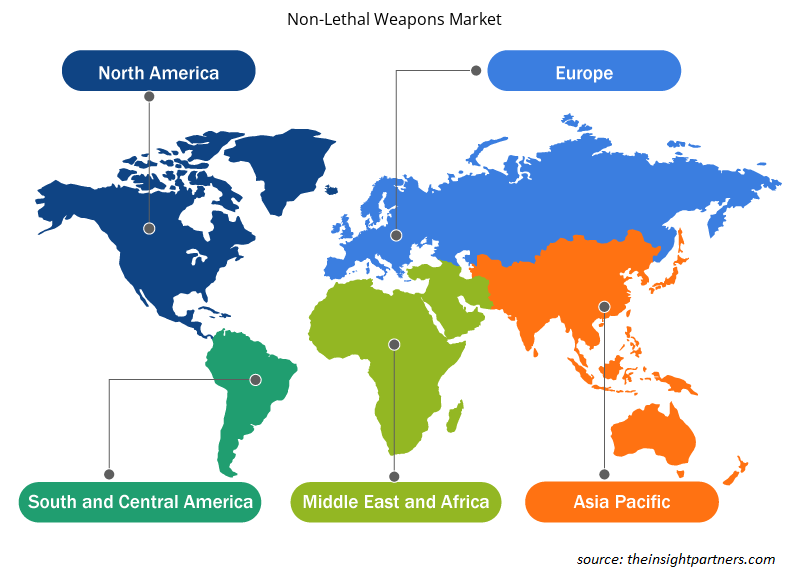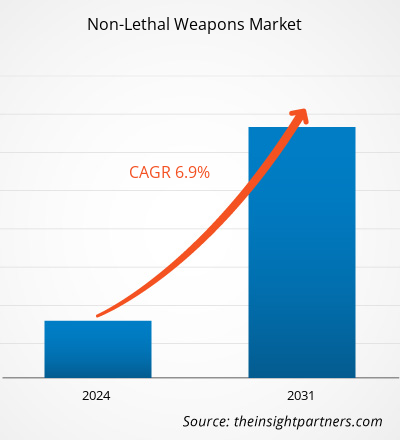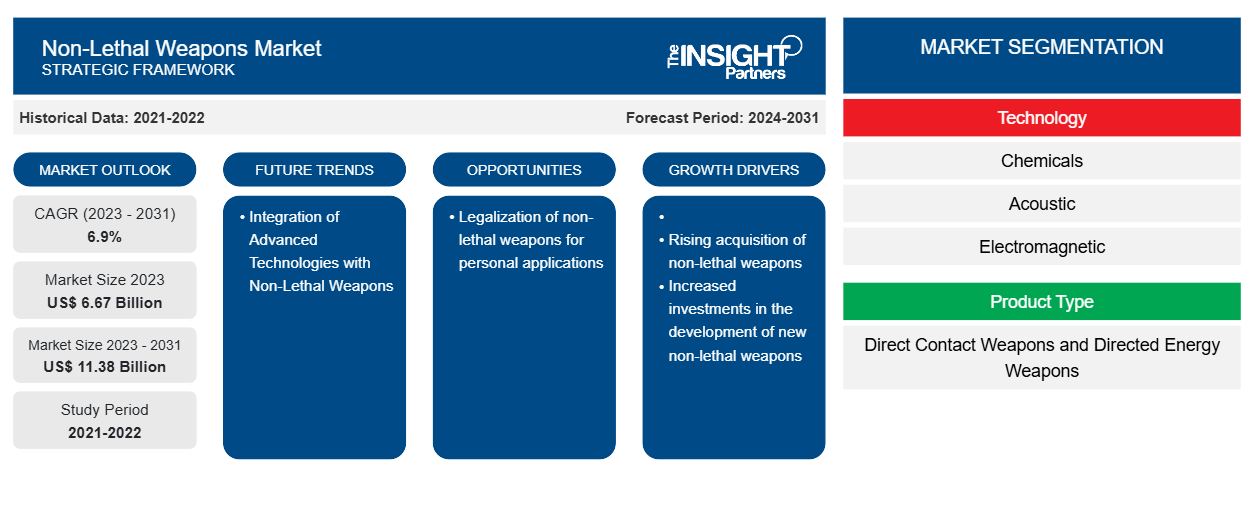非致命武器市场规模预计将从 2023 年的 66.7 亿美元增至 2031 年的 113.8 亿美元。预计 2023-2031 年期间市场复合年增长率将达到 6.9%。先进技术与非致命武器的融合可能仍是市场的主要趋势。
非致命武器市场分析
某些特定产品类别的产品差异化程度较低,例如电击枪、警棍和胡椒喷雾,这些是最终用户最常使用的非致命武器。此外,在某些情况下,有关民用非致命武器使用的严格规定也导致个人用户产生犹豫。这些因素已经影响了多个细分市场的市场。
非致命武器市场概况
国内动乱的增加和执法机构的军事化是支持非致命武器市场增长的主要因素。然而,一些发展中国家严格的环境和政府法规限制了非致命武器市场的增长。
此外,美国、以色列等多个国家的犯罪率上升和骚乱抗议活动也推动了不同地区非致命武器市场的采用。
定制此报告以满足您的需求
您可以免费定制任何报告,包括本报告的部分内容、国家级分析、Excel 数据包,以及为初创企业和大学提供优惠和折扣
-
获取此报告的关键市场趋势。这个免费样品将包括数据分析,从市场趋势到估计和预测。
非致命武器市场驱动因素和机遇
增加对新型非致命武器研发的投资
由于多国政府颁布了不同的有争议的法律和法规,各地区的不稳定性不断上升,这增加了对低伤亡风险武器的需求。人权立法者和政府制定了法规,要求多个安全和防御组织采购杀人风险较低的武器。对低致命性武器的需求增加,促进了新型和先进非致命武器的开发。全球非致命武器市场的一些主要参与者包括 FN HERSTAL、Lamperd Less Lethal、Combined Systems, Inc.、Pepperball 和 Rheinmetall AG。
先进技术与非致命武器的融合
非致命武器因其先进的功能和在不造成人员伤亡的情况下平息骚乱的能力而变得越来越受欢迎。国防公司和主要市场参与者利用先进技术改进了其产品组合,包括激光拦截系统、远程声学设备、升级的水下扩音器、闪光弹、声学呼叫设备、模块化人群控制武器和电击枪。这些技术在非致命武器中的集成正在推动非致命武器市场的增长。
非致命武器市场报告细分分析
有助于得出非致命武器市场分析的关键部分是技术、产品类型和应用。
- 根据技术,非致命武器市场分为化学武器、声学武器、电磁武器、机械和动能武器。机械和动能武器在 2023 年占据了较大的市场份额。
- 根据产品类型,非致命武器市场分为直接接触武器和定向能武器。直接接触武器部分在 2023 年占据了更大的市场份额。
- 根据应用,市场分为执法机构、军事和个性化应用。执法机构在 2023 年占据了最大的市场份额。
非致命武器市场份额(按地区)分析
非致命武器市场报告的地理范围主要分为五个地区:北美、欧洲、亚太、中东和非洲、南美。
2023 年,北美占据了市场主导地位,其次是欧洲和亚太地区。此外,亚太地区未来几年的复合年增长率可能最高。区域参与者在先进非致命武器开发方面的投资不断增加,预计也将推动非致命武器市场的增长。例如,一家位于北方邦的印度公司开发了 Varja 和 Trishul 等非致命武器,用于在加勒万河谷冲突后保护其军队免受突然袭击。因此,上述这些因素正在推动亚太地区非致命武器市场的增长。
非致命武器市场区域洞察
Insight Partners 的分析师已详细解释了预测期内影响非致命武器市场的区域趋势和因素。本节还讨论了北美、欧洲、亚太地区、中东和非洲以及南美和中美洲的非致命武器市场细分和地理位置。

- 获取非致命武器市场的区域特定数据
非致命武器市场报告范围
| 报告属性 | 细节 |
|---|---|
| 2023 年的市场规模 | 66.7 亿美元 |
| 2031 年市场规模 | 113.8亿美元 |
| 全球复合年增长率(2023 - 2031) | 6.9% |
| 史料 | 2021-2022 |
| 预测期 | 2024-2031 |
| 涵盖的领域 |
按技术分类
|
| 覆盖地区和国家 |
北美
|
| 市场领导者和主要公司简介 |
|
非致命武器市场参与者密度:了解其对业务动态的影响
非致命武器市场正在快速增长,这得益于最终用户需求的不断增长,这些需求源于消费者偏好的不断变化、技术进步以及对产品优势的认识不断提高等因素。随着需求的增加,企业正在扩大其产品范围,进行创新以满足消费者需求,并利用新兴趋势,从而进一步推动市场增长。
市场参与者密度是指在特定市场或行业内运营的企业或公司的分布情况。它表明在给定市场空间中,相对于其规模或总市场价值,有多少竞争对手(市场参与者)存在。
在非致命武器市场运营的主要公司有:
- BAE系统公司
- 联合系统有限公司
- 秃鹰非致命技术
- 赫斯塔尔新生力量
- Lamperd 公司
免责声明:上面列出的公司没有按照任何特定顺序排列。

- 获取非致命武器市场顶级关键参与者概述
非致命武器市场新闻和最新发展
非致命武器市场的评估是通过收集一手和二手研究后的定性和定量数据进行的,其中包括重要的公司出版物、协会数据和数据库。以下列出了非致命武器市场的一些发展情况:
PepperBall 是创新型非致命执法解决方案的领导者,它自豪地宣布将在今年的 SHOT Show 72205 展位上推出其重新设计的 TAC-SA 型号 - TAC-SA PRO 和 TAC-SA PRO PLUS。这些发射器代表了非致命响应解决方案的最新进展,并可根据执法专业人员的不同需求进行量身定制。(来源:PepperBall,新闻稿,2024 年 1 月)
- PepperBall 是执法部门非致命解决方案领域的领导者,该公司自豪地宣布推出重新设计的 FTC PRO 和 FTC PRO PLUS 发射器。这些最先进的型号将在 2024 SHOT Show 上展出。FTC PRO 和 FTC PRO PLUS 旨在满足执法专业人员不断变化的需求。虽然这两种发射器都具有一些创新功能,但每种发射器都有针对特定操作需求量身定制的独特方面。(来源:洛克希德马丁澳大利亚公司,新闻稿,2024 年 1 月)
非致命武器市场报告覆盖范围和交付成果
“非致命武器市场规模和预测(2021-2031 年)”报告对市场进行了详细分析,涵盖以下领域:
- 范围内涵盖的所有关键细分市场的全球、区域和国家层面的非致命武器市场规模和预测
- 非致命武器市场趋势以及市场动态,如驱动因素、限制因素和关键机遇
- 详细的波特五力分析
- 非致命武器市场分析涵盖主要市场趋势、全球和区域框架、主要参与者、法规和最新市场发展
- 行业格局和竞争分析,涵盖市场集中度、热图分析、知名参与者以及非致命武器市场的最新发展
- 详细的公司简介
- 历史分析(2 年)、基准年、预测(7 年)及复合年增长率
- PEST和SWOT分析
- 市场规模、价值/数量 - 全球、区域、国家
- 行业和竞争格局
- Excel 数据集
近期报告
客户评价
购买理由
- 明智的决策
- 了解市场动态
- 竞争分析
- 客户洞察
- 市场预测
- 风险规避
- 战略规划
- 投资论证
- 识别新兴市场
- 优化营销策略
- 提升运营效率
- 顺应监管趋势























 获取免费样品 - 非致命武器市场
获取免费样品 - 非致命武器市场